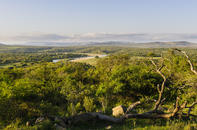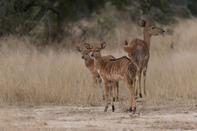A Startling Discovery
Professor William Bond of the University of Cape Town's botany department has been unearthing how trees work in the KwaZulu-Natal savannah. A slow and steady change has come over parts of the area in the past fifty years. Trees and thickets have crept over the landscape - thick, green and impenetrable.

Farmers who have appropriated land for grazing have noticed it. Photographs taken in parts of Hluhluwe-iMfolozi Park in the 1940s show wide, open spaces and paths that today are congested with dense thickets. The financial implications are severe for both parties - loss of grazing for farmers and possible loss of tourism revenue for parks where their visitors can no longer view game.
Scientists such as Bond have looked at grazing and the management of the fire regime to explain this shift from Savannah to woodland. When they looked at carbon dioxide (CO) concentrations present in the atmosphere, they made a startling discovery: an increase in atmospheric CO be 'fertilising the trees’, making them tick over like a fuel-injected car engine.
Photosynthesis is Crucial to All

During daylight hours, trees 'breathe' in atmospheric carbon dioxide through the stomata (tiny holes in the surface of their leaves), at the same time losing water to the atmosphere from the moist interior of the leaves. Energy from sunlight is absorbed by the leaves, and water is replaced in the leaves once it has been transported from the roots by specialised veins.
Through a chemical process in leaves (photosynthesis), CO and water combine to form oxygen and carbohydrates such as sucrose. During daylight hours, oxygen is expelled through the stomata while CO is absorbed to make carbohydrates, which are dissolved in the water and carried off to the rest of the plant. Here they are used to build the carbon-rich structure of the plant.
This is the engine upon which the rest of life on this planet is completely dependent. Without photosynthesis, there would be no food chain, no breathable atmosphere and no daily grind from which, you and I can escape at weekends. If you add more CO to the mix, it makes sense that you are going to get more carbohydrates for the plant - add more sugar to the water bottle of an athlete and wait for the energy surge.
Tree Experiment
Bond and his colleagues at the South African National Biodiversity Institute (SANBI), Dr Guy Midgley and Barney Kgope, put a few typical savannah trees into small chambers with a controlled atmosphere, to see how they would respond to simulations of the different levels of CO experienced on the planet since the most recent glacial period about 18 000 years ago.
In the SANBI experiments, trees were allowed to grow in a CO level of 180 parts per million (ppm) estimated for post-glacial conditions, in the 270 ppm of the pre-industrial era, and in present-day's 370 ppm. Some were grown in CO concentrations as high as 550 ppm, anticipated for the year 2050, as well as in 750 ppm and 1 000 ppm.
Results showed that, under pre-industrial conditions, trees would have grown very slowly with less CO available for building their carbon-rich architecture. However, savannah grasses would have thrived as they don't require much carbon - 12 000 years ago, the eastern parts of South Africa would not have seen the typical browsing wildlife we associate with savannahs today.
But as CO levels in the experiments were increased, so too did the growth rate and robustness of the trees, both above and below the ground. Even when trees were clipped to simulate fire damage, the recovery rate was astonishing under simulations of current CO conditions compared with those of 150 years ago.
Does it Solve Climate Change?
It appears that CO is a major factor driving the increasing abundance in tree saplings in savannahs. Where saplings would have died out as fires swept through the veld, they now appear to have enough carbohydrate reserves to re-sprout. Saplings are probably able to grow faster and to push quickly above the height where fire is lethal for them.
Once they break through this 2 m to 4 m 'fire trap' and reach escape height, they have a good chance of reaching maturity. Grasses, which thrived in the low CO conditions of 12 000 years ago would find themselves backed up against the wall as the balance tipped in favour of super-fuelled trees.
Initially, it would seem that a changing climate will benefit trees - and trees are supposed to mitigate against global warming by absorbing the CO produced by burning fossil fuels. Surely this should be the answer to the problem of global climate change? It's not.
Heading Towards Forestation

Computer modelling has shown that, even if Southern Africa were completely covered by trees, the amount of carbon absorbed from the atmosphere would be negligible in global terms.
The bioclimatic modelling in the South African Country Studies Report, commissioned by the government in the late 1990s but only released to the public in a modified form in 2004, showed that the factors, which shift savannah-type rangelands along the scale between forest and grassland will shift back and forth could push savannahs towards forestation.
If minimum temperatures climb, the incidence of frost will decrease - frost has the same effect on saplings as fire, cutting them back and keeping the savannah stable. If frost reduces, saplings will have a greater chance of success. Both these factors suggest that savannahs will be shunted towards forest-type vegetation. But throwing a spanner in the works is the trend towards aridification in savannahs.
Aridification

Temperatures will climb by about 2.5°C to 3.5°C, with periodic drought stress probably gaining in severity, which will favour the success of grasses over trees. Anyone who has even given passing attention to how plants grow will have seen how they slow down in colder weather, wilt in very hot weather, and thrive at some point in between. Plot that on a graph and the result is hump-shaped. The optimum temperature for grass growth is about 30°C whereas trees and shrubs are usually around 25°C.
Growing season daytime temperatures in South African rangelands are already close to or above this limit, states the Country Studies Report. While it's unlikely that 'lethal maximum temperatures' for trees will be reached, the estimated 2°C increase will stunt their growth.
Increased evaporation and hence aridification under these conditions will shorten the growing season for trees if they are not made more water-efficient under stomata as wide to breathe in, meaning less water is lost in the process and the tree then uses water more sparingly. With all these factors pulling the savannah back and forth, how can we know where it will be fifty years from now? Will it be grassland, woodland, or much as it is now?
Dr Bob Scholes from the Council for Scientific and Industrial Research (CSIR), who has worked closely with Prof. William Bond on these studies, believes that the levels of CO that are beneficial to plant growth have long been exceeded, probably at about 280 ppm. Temperature and water are the two key factors for the future. A place like the Kruger National Park is already on the hot side of the temperature hump, meaning the region is heading away from optimal growth temperatures for trees and into dangerous territory.
By Leonie Joubert